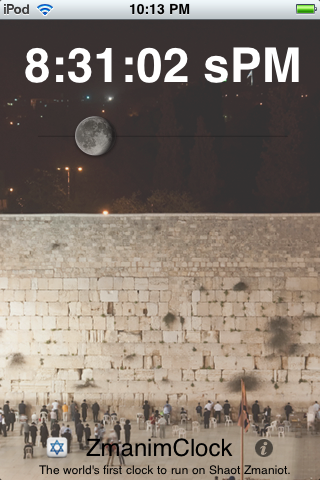iPhone App | About Shaot Zmaniot | Easy Zmanim | Contact Us
ZmanimClock
The world's first clock to run on Shaot Zmaniot.
About Shaot Zmaniot
The Bottom Line
Synagogues around the world publish weekly times for davening, Shabbat, etc., which change from day to day and from place to place. If you are running ZmanimClock, however, you only have to remember one set of times, since the clock changes as needed.
About Seasonal Time / Sha'ot Zmaniot / שעות זמניות
Sha'ot Zmaniot, sometimes translated as Seasonal Time, refers to time that changes as a function of the number of hours of daylight. The origins of this method of time keeping are in agricultural societies, in which people rose with the sun and ended their day when there was no more light. In these cultures, the "real" time "6:45AM" doesn't mean anything, whereas "within an hour of sunrise" is roughly equivalent to "when you wake up".
Thus, certain commandments (mitzvot) that are tied to times of the day, are frequently expressed in terms of the seasonal time. For example, one must recite shma "when you wake up" -- and the discussions in the Talmud center around what time that would be. Whatever the final answer is, the important idea is that the time be close to when you wake up, in other words close to sunrise, and thus the time ends up being seasonal. Similarly, Shabbat starts Friday evening at sundown, regardless of what the real time is.
Which Times Are Seasonal/Zmaniot?
While certain times are tied to sunrise and sunset, others are tied to the amount of light or dark before sunrise or after sunset. This method of time is sometimes called "shitat hamaalot", or the "degrees" technique, by which times are measured by the number of degrees that the sun goes beneath the horizon, which has a proportional relationship to the amount of incidental light visible at that time. Since the earth rotates with constant REAL time (non constant SEASONAL time), the number of minutes corresponding to a degree does not correspond to a fraction of the number of hours of night.
To illustrate, imagine you lived high in the northern hemisphere, at a time of the year where there was only 1 hour between sunrise and sunset. If "dark" were defined as 1 seasonal hour, it would be 1/12 of one hour (or 5 minutes) after sunset, which is clearly not the case. Instead, dark is defined as some number of degrees below the horizon, which at those latitudes might never happen during certain times of the year.
Walking Times: Timing By Proxy
Since measuring latitudes, longitudes, sunrise times, etc. are not trivial calculations, and more problematically, vary from time to time and place to place, the rabbis devised a proxy for determining the number of degrees. Assuming the number of real minutes per degree of sun-motion below the horizon is constant (which is not totally correct, but nevertheless is not too far off), and assuming that the "average" person walks at a certain speed, one can express time in terms of distance, and speak of "the time it takes to walk x units of distance", which at the time of the Talmud was a "mil" (not the same as our mile today). Science does the inverse today in talking of distance in terms of time, as in the concept of a light-year.
ZmanimClock: Fixed Times and Varying Times
On ZmanimClock, the prayer times that are "zmaniot" end up being fixed on the clock: 9sAM for finishing shma, 12:30sPM for earliest mincha, etc.
The times that are tied to degrees of darkness, such as first light, "misheyakir", Shabbat ending, etc. vary and do not have fixed times on ZmanimClock. They also vary slightly at different latitudes and different times of year, as the number of minutes it takes the sun to move one degree is mostly ~4 minutes but can change slightly. On ZmanimClock, these are calculated dynamically based on the number of degrees that sun is below the horizon, which reflects directly the amount of darkness.
One interesting case is candle-lighting Friday afternoon. The notion of 18 minutes seems more related to "tosefet Shabbat", or adding some time before Shabbat really starts so we don't just rush into it, and thus you could fix candle-lighting on ZmanimClock to be 5:42 sPM, even if this would not always line up with candle lighting on the real clock. Havdalah and Shabbat ending, unfortunately, will be different times at different times of the year.
For example, one opinion holds that absolute darkness takes "the time to walk 4 mil" after sunset. Depending on how long you think it takes to walk 1 mil, this can vary from 72 to 90 minutes. And in fact, the idea that "alot hashachar", or dawn, is 72 minutes before sunrise comes from this formula.
Acknowledgements
Special thanks to to Rabbi Aharon Brisk, author of Otzar Hazmanim, for his help putting these ideas together and for his encouragement throughout the ZmanimClock project. Copies of Otzar Hazmanim can be ordered .


